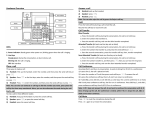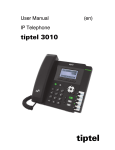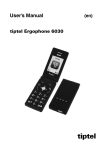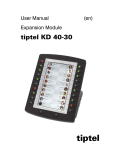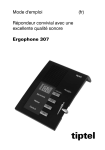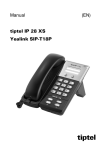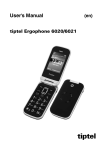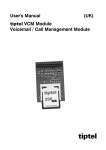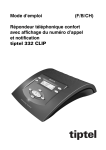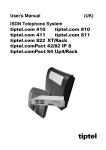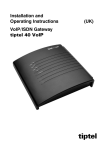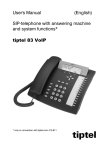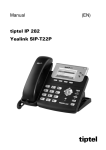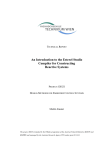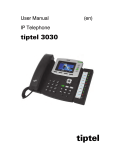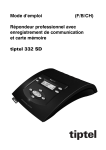Download English - Tiptel
Transcript
User manual (en) Ergonomic telephones Ergophone C Ergophone CR tiptel Overview of the operation elements Table of contents Making telephone calls comfortable.................................... 3 Safety information.................................................................. 4 Operation elements................................................................ 7 Keys and their functions............................................................................... 7 Slide switches for volume adjustments......................................................... 8 Symbols in the display.................................................................................. 8 Illumination of key pad and display............................................................... 9 Making telephone calls........................................................ 10 Manual dialling............................................................................................ 10 Dialling with off-line call preparation........................................................... 10 Dialling via speed dialling keys................................................................... 11 Dialling a number in the phone book.......................................................... 12 Sending an emergency call........................................................................ 12 Manual interruption of an emergency call................................................... 14 Sending an emergency call via pendant..................................................... 15 Manual interruption of a distress radio call................................................. 16 On-Hook-Dialling........................................................................................ 16 Redialling.................................................................................................... 16 Automatic redialling.................................................................................... 17 Abbreviated dialling.................................................................................... 18 Call number chaining (call-by-call function)................................................ 19 Dialling the last telephone number transmitted ......................................... 19 Ringing signal volume................................................................................ 20 Handset volume.......................................................................................... 20 Loudspeaker volume.................................................................................. 21 Listening-in................................................................................................. 21 1 Table of contents Hands-free operation.................................................................................. 22 Switching between handset and hands-free operation............................... 23 Extended telephone functions............................................ 24 Dialling via direct call.................................................................................. 24 Recording of call passages........................................................................ 24 Recording of call passages via speed dialling key 5.................................. 25 Do-not-disturb function............................................................................... 26 List of released numbers for ringing signals............................................... 26 List of restricted numbers for ringing signals.............................................. 26 Ringing melody........................................................................................... 27 Incoming call indication by flashlight.......................................................... 27 Display lightness adjustment...................................................................... 27 Call restriction............................................................................................. 27 Support for hearing aid users..................................................................... 28 Operation with headset............................................................................... 28 Display language........................................................................................ 28 Room monitoring........................................................................................ 29 Vital sign function....................................................................................... 30 Special features by the telephone network provider................................... 30 Appendix............................................................................... 31 Short operating instructions........................................................................ 31 Error messages.......................................................................................... 33 Cleaning the device.................................................................................... 34 Index...................................................................................... 35 2 Making telephone calls comfortable Making telephone calls comfortable This telephone was designed to allow the user a relaxed, comfortable and easy way to make phone calls. Clear structure The large keys, slide switches and display are clearly arranged. Thanks to the built-in movement detector, the illumination of the key pad and the display is automatically switched on when e. g. your hand approaches the device. Simple operation The volume of the loudspeaker, ringing signal and handset can be easily adjusted via slide switches. The function keys are clearly marked. Safe handling The handset can easily be replaced and stays on its non-slip rest. You can make outgoing telephone calls even in the case of a power failure. If required, an emergency call function can be programmed. Modern technology The „call number transfer for incoming calls“ is just one of the outstanding modern functions provided by this telephone. Quality made in Germany. 3 Safety information Safety information Please follow the safety information in the programming instructions on page 5. Intended use This telephone is suited to be connected to analogue line interfaces of public switched telephone networks. DANGER -Never try to unscrew the screws and open the device. You could get in contact with current-carrying parts. -Never touch the connector contacts with pointed or metallic objects. WARNING The telephone was produced for standard use conditions. Please do not install the device -close to heat sources (air-conditioning, heater, exposure to direct sunlight), -in humid rooms (no exposure to splashing water or chemi- cals), -nearby devices emitting strong magnetic fields (electrical appliances, fluorescent tubes, computers, TV sets), -in dusty rooms, -in rooms where the device is exposed to vibrations or extre- me variations in temperature. CAUTION -Never carry the telephone at the handset or the connection cables. 4 Safety information -Only plug the connecting cables into the designated recep- tacles. -Make sure that the connecting cables are laid in a way that accidents are prevented. -If necessary, install additional sockets. Some furniture lacquers or furniture cleaning products may attack the rubber at the feet of the telephone and thus cause patches. In such cases, please use a non-slip pad under the device. Batteries DANGER The batteries are to be used strictly. Batteries should be replaced as soon as the battery symbol is displayed. For safety reasons, we recommend to exchange the batteries once per year as discharged batteries may be subject to leakage and thus could damage the device. Please dispose of discharged batteries environmentally (no domestic rub- bish). AC adapter DANGER Only use the AC adapter from the scope of supply. Make sure that during operation, the AC adapter is plugged and connec- ted to the power supply system. Headset You may only use and connect headsets that meet the safety requirements of IEC 60950 item 6.2. (connection to TNV 3 circuits). For more information, please contact your specialist dealer or headset manufacturer. 5 Safety information Emergency call function DANGER In rare cases, the function of sending out an emergency call cannot be guaranteed. This might be the case if e. g. the telephone network fails or if the radio transmission from the transmitter to the telephone is subject to interference. If the device is used for people who are in a critical or life-threate- ning health condition, you should not refrain from additional safety means. Wireless pendant (variant with radio emergency function only): DANGER If the wireless pendant is worn around the neck by means of the cord, please consider the following: •The wireless pendant should only be worn in front of the upper part of the body and above the clothing. It then can easily be accessed at any time. •The cord has been developed and designed to break when exposed to extra ordinary high mechanical load. Despite of this, a risk of injury cannot be completely excluded. It is recommended to wear the wireless pendant around the wrist when helping laid up persons. •Only use an original cord to replace a faulty one. Do not try to repair the cord on your own (e. g. by making a knot). Wireless pendant and cord should be kept out of reach of small children. Take the telephone out of operation Unplug the AC adapter and the telephone line. Afterwards, take the batteries out of the battery compartment! 6 Operation elements Operation elements Keys and their functions Loudspeaker key: - “hands-free operation”: seize line, disconnect line. - “listen-in function”: activation / deactivation during a call. - switching between handset and hands-free operation. Redial key: A call is established to the subscriber number dialled last. Programming key: Used to initiate programming steps, i. e. start and complete the programming. Recall key e. g. for call transfers if the device is connected to a telephone system. Triangular key: Depending on the basic settings, the handset volume for the current call can be either raised or lowered. SOS (emergency call) key (key on the very top): direct dialling of emergency numbers - if programmed. # . Interrupt emergency call. Speed dialling key: direct dialling of a stored telephone number. Automatic redialling: If the target subscriber number is busy, press the keys consecutively and replace the . handset Dialling the transferred telephone number of the last incoming call: press the keys consecutively and pick . up the handset 7 Operation elements Dialling a number in the phone book. Press P key and enter the first letter of the name. If there are more entries: Select the desired entry by the arrow keys. (After pressing the P key, your are able to scroll through all entries of the phone book). Recording of call passages: press the P-key. Afterwards press the triangular key and keep it pressed. Play-back: press the keys consecutively while the handset is on-hook. Slide switches for volume adjustments Ringing signal volume. Loudspeaker volume. Handset volume. Please note the section “Handset volume” on page 20. Symbols in the display R Automatic redialling active. Select phone book entry. There is an unanswered call. The transferred telephone number can be displayed. A programming step is executed. Listening-in or hands-free mode is active. Incoming call indication by flashlight is activated. 8 Operation elements The basic setting “Handset very loud” is turned on. The batteries of the phone are nearly discharged and should be replaced. Headset operation is activated. Illumination of key pad and display Illumination on: Illumination off: When there is an incoming call or when your hand moves to the telephone. After you have finished a call or if you leave the tele- phone 40 sec. without moving. The numeric key “5” is always lit for better orientation, even if the display or the key pad light is off. 9 Making telephone calls Making telephone calls Normally, you initiate a telephone call by picking up the handset. This is described in the following paragraphs. As an alternative, you can also initiate a telephone call by pressing the loudspeaker key. In this case, the telephone automatically activates the hands-free operation. This option is not described further in the following paragraphs. Manual dialling Pick-up the handset, wait for dialling tone. Dial telephone number, ringing tone or busy tone. Start conversation when target subscriber answers the call. Replace the handset. Remark: When an incoming call is indicated by the ringing signal, you can answer it by either picking up the handset or pressing the loudspeaker key. Incoming calls are also indicated optically (if no telephone number is transferred): Call Dialling with off-line call preparation You can also use the off-line call preparation when making telephone calls. Just dial the telephone number of the target subscriber, check the number in the display and seize the line afterwards. 10 Making telephone calls Dial complete telephone number. Pick-up the handset. The telephone number is being dialled. Replace the handset to finish the call. Remark: When you dial telephone numbers using the off-line call preparation, you can delete individual numbers by pressing the P-key. Dialling via speed dialling keys There are 4 speed dialling keys available. If you do not use the top key as emergency call key (see next paragraph), you can also use this key as an additional speed dialling key. Press the desired speed dialling key. The selected target subscriber number is shown in the display and will be dialled. The hands-free mode is activated. Pick-up the handset when the subscriber answers the call or stay with the hands-free mode. End of call: Replace the handset or complete the hands-free operation by pressing the loudspeaker key. Remark: Please refer to page 18 of the programming instructions to see how to store the speed dialling numbers. 11 Making telephone calls Dialling a number in the phone book You can dial names and telephone numbers which are stored in the phone book. Press the P-key. Enter the first character of the wanted name with the digit keys. The display shows: „Search for...“ The name appears in the display. If there are more entries with the same first character, you are able to select the desired name with the arrow keys and . Pick up the handset. The telephone number is shown in the display and will be dialled. Remarks: • To enter a specific alphanumeric character, press one or more times the key labelled with the required character: once for the first character, twice for the second and so on. • If you want to view the whole phone book list, press the P-key and after- wards the arrow keys. • Please refer to page 19 of the programming instructions to see how to store phone book entries. Sending an emergency call The individually positioned upper speed dialling key (1) can be programmed 12 Making telephone calls and used as an emergency or SOS key. After pressing the SOS key, up to four stored telephone numbers are called one after the other. Press the SOS key. Emergency No. 1 The display shows the currently dialled emergency number (emergency number 1 - 4). Person seeking help Recipient of an emergency call Press SOS key. Telephone is ringing. Pick-up the handset. The emergency announcement is heard. Press numeric key 5 (acknowledgement). The emergency announcement is stopped. The emergency call telephone is automatically switched to the hands-free mode. Conversation with person seeking help. End conversation: Press loudspeaker key. Remarks: The emergency call has priority over all other telephone activities and can be set in different ways (see programming instructions as of page 25). • The emergency operation must be set up and activated via the program- ming. • You can store a maximum of 4 emergency numbers. • You can set up to 9 emergency call dialling sequences. During one se- quence, all programmed telephone numbers are called one after the other. 13 Making telephone calls • • • • • • • The pause between the individual emergency dialling sequences can be up to 9 minutes. During the pause - after completion of one emergency call dialling sequence - the red LED blinks. During an emergency call dialling sequence the LED is lit constantly. An emergency number can be called for a duration of 1 - 99 sec.. If there are incoming calls while an emergency call is made, these incoming calls are not answered as the emergency call always has priority. Existing calls are automatically disconnected as soon as an emergency call is initiated. When an emergency call service is called, the recipient of the emergency call can use an identification code to get immediate information on the person seeking help. You can record an individual emergency announcement. The person receiving your emergency call will then hear this announcement as soon as the call is answered. If the emergency call is picked up an answering machine, then it does not stop but automatically dials the next number. The emergency call only stops when it has been received and acknowledged (by inputting the number key 5). At the end of the first run of emergency calls, a three-time signal tone indicates that no further run is to follow. Manual interruption of an emergency call The programmed emergency calls are made after pressing the SOS key (see last paragraph). Should you press the SOS key mistakenly, you can stop the emergency call procedure by the following key sequence. # Press the P-key and the rhombus key sequentially. The emergency call is interrupted. 14 Making telephone calls Sending an emergency call via pendant The variant with radio emergency function comprises a radio transmitter (pendant) which can be used to send emergency radio calls. Up to 9 stored radio call numbers are dialled sequentially after pressing the transmitter key. You also have the option to set up an „internal emergency call“. In this case, the own telephone will ring with a special ringing melody. Press the SOS key of the pendant. (1) Radio SOS 1 On the left side of the display, the number of the radio transmitter is shown in brackets. On the right side of the display, the corresponding dialled distress radio call number is shown. The procedure of sending a distress radio call corresponds to the procedure as described under „Sending an emergency call“ (instead of pressing the telephone‘s SOS key, the radio transmitter key has to be pressed). Remarks: • If the emergency call is picked up an answering machine, then it does not stop but automatically dials the next number. The emergency call only stops when it has been received and acknowledged (by inputting the number key 5). • At the end of the first run of emergency calls, a three-time signal tone indicates that no further run is to follow. • Refer to the programming instructions (as of page 31) to see how dis- tress radio call numbers are stored and how to have the radio transmitter registered. • Dialling the 9 (as a maximum) distress radio call numbers can only be initiated via the radio transmitter. Dialling the 4 (as a maximum) emer15 Making telephone calls gency call numbers can only be initiated by pressing the SOS key at the telephone. Manual interruption of a distress radio call Should you have initiated a distress radio call mistakenly, you can stop the process via the following procedure to be conduced at your telephone: # Press the P key and the rhombus key sequentially. The emergency call is interrupted. On-Hook-Dialling You do not need to pick-up the handset in order to start the dialling process. Only as soon as the target subscriber answers your call, pick-up the handset as usual. Press the loudspeaker key. Dial the telephone number. Pick-up the handset as soon as the subscriber answers your call. Start conversation. Redialling When the called subscriber does not answer the call as he/she is having another telephone conversation or is not present, you can repeat the dialling process by just pressing one key. The target subscriber number may only have 20 digits as a maximum. Pick-up the handset. 16 Making telephone calls Press the redial key. 123456789 Hold conversation as soon as the subscriber answers the call. Remark: Each newly dialled telephone number will overwrite the earlier made entry for redialling. Automatic redialling If the called target subscriber number is busy, the dialling process for the telephone number dialled last can be repeated automatically up to 10 times. Start automatic redialling: You have dialled a telephone number and the target subscriber is busy: Press the P key. Press the redial key. 123456789 Auto Replace the handset. The telephone initiates a pause of up to one minute and then repeats the dialling process up to 10 times (depends on the individual settings). As soon as the called subscriber answers the call: Pick-up the handset, Hold conversation. Stop automatic redialling: In the idle state, press any key. The automatic redialling process is stopped. 17 Making telephone calls The automatic redialling process is stopped automatically if the target subscriber has not answered the call after 10 dialling attempts. Remarks: • The automatic redialling is also activated if you press the P key and the redial key while the handset is on-hook. If the called party answers the call, you can hear him/her via the loudspeaker. Pick-up the handset or press the loudspeaker key to hold the conversation. • Your telephone comes with the following factory pre-set: The target sub scriber‘s telephone will ring for one minute after activation of the automatic redial process. Afterwards, there will be a pause for one minute. After the pause, the target subscriber‘s telephone will ring for one minute again. This process is repeated up to 10 times (on the condition that nobody answers your call). These settings can be adjusted individually. For refer- ence, see the programming instructions as of page 39. Abbreviated dialling You have the option to store up to 10 frequently used telephone numbers and thus abbreviate the dialling process. The telephone numbers to be stored may have 20 digits as a maximum. They are stored under call number memory stations 0 - 9 (numeric key pad). Pick-up the handset. 0-9 Press the corresponding numeric key (0-9) for minimum 3 seconds. The telephone number appears in the display and is dialled automatically. Hold conversation as soon as the called party answers the call. 18 Making telephone calls Remark: Please refer to the programming instructions (as of page 19) to see how abbreviated numbers are stored. Call number chaining (call-by-call function) Your telephone provides the option to chain telephone number segments which are stored under different memory stations. This is useful e. g. if you want to dial a telephone number using a specific destination network code (call-by-call function). Example: You have stored a telephone number on memory dialling location 0 and a destination networkcode on speed dialling location 1. 0 Press speed dialling key 1. Wait until the destination network code has been dialled. Press the numeric key 0 for 3 seconds minimum.The telephone number is then linked to the destination network code. The two numbers are shown in the display and are dialled sequentially. Dialling the last telephone number transmitted The „transmission of the caller‘s telephone number“ is a service provided by the telephone network provider and possibly has to be applied for and released. A telephone number transmitted with a call is automatically stored. You can view the number and dial it. If the corresponding name is transmitted (e.g. from a PABX) or if the name is registered in the phone book, it appears. If there is an unanswered incoming call, „R“ is shown in the display‘s symbol bar. You can then view the name / telephone number and will know who had called you. You may then dial this telephone number directly. 19 Making telephone calls Press the P key. Press the R key. Name respective telephone number appears in the display. If the name appears, you can toggle with the R-button between name and telephone number. Pick-up the handset. The telephone number is dialled automatically. Remarks: • After having pressed the R key, the telephone number is displayed for 40 seconds. • The feature „transmission of the caller‘s telephone number“ is also known as „CLIP“ (Connected Line Identification Presentation). Ringing signal volume The ringing signal volume can be adjusted by the left slide switch. Handset volume The telephone can be set for „Handset volume normal loud“ or „Handset volume very loud“ (See programming instructions on page 22). As a sign of the setting „Handset volume very loud“ activated, the handset symbol appears in the display. With the right slide switch, different volume in the programmed volume range can be adjusted. Slide the right slider to the left: the volume is reduced. Slide the right slider to the right: the volume is raised. 20 Making telephone calls During a call, the handset volume can be changed: Press the triangular key while the call is in progress. If the volume range „very loud“ is set, the volume will be reduced. If the the volume range „normal loud“ is set, the volume will be raised. After hanging up the handset, the set volume range is automatically re-set. Remark: Set the handset volume in a way that for most of the users of the phone the volume is comfortable. If a person needs to have another handset volume setting, he can change the volume easily by pressing the triangular key. Loudspeaker volume The loudspeaker volume can be adjusted by the slide switch positioned in the middle. Listening-in You can activate the loudspeaker during a call so that the conversation can be heard in the room. Activate the loudspeaker: Press the loudspeaker key. Deactivate the loudspeaker: Press the loudspeaker key. 21 Making telephone calls Remark: The loudspeaker volume for listening-in set via the slide switch is also retained for the next call. Hands-free operation In addition to the listening-in function, the hands-free mode allows to hold a telephone conversation while the handset is on-hook. You receive a call: Press the loudspeaker key. The hands-free mode is activated. End conversation: Press the loudspeaker key. The hands-free mode is deactivated. You call a subscriber: Dial the telephone number (manually or via abbreviated numbers). Press the loudspeaker key. The hands-free mode is activated and the telephone number is dialled. End conversation: Press the loudspeaker key again. The hands-free mode is deactivated. Remark: When pressing a speed dialling key, the telephone automatically switches to the hands-free mode and the telephone number is dialled. 22 Making telephone calls Switching between handset and hands-free operation You are holding a telephone conversation and now intend to switch from the handset to the hands-free mode. Press the loudspeaker key and keep it pressed while replacing the handset. Afterwards, release the loudspekaer key. The hands-free mode is activated. If you want to resume the handset operation, just pick- up the handset and the hands-free mode is deactivated. 23 Extended telephone functions Extended telephone functions Dialling via direct call When the „direct call“ feature is active, it is possible to dial a specific stored telephone number by pressing any key (except for the loudspeaker and the SOS key). The direct call is often also called „baby call“. It makes it much easier for the child to call the parents as the telephone number is stored and pressing any key (except for the loudspeaker and the SOS key) allows to establish the call. The activation of the „direct call“ function Direct call can be identified in the display: Pick-up the handset. Press any key (except for the loudspeaker and the SOS key). The programmed direct call number is dialled. Remarks: • When the direct call function is active, no other telephone functions are executable. Exceptions: The stored emergency numbers of police and fire-brigade can be called. If the emergency call mode is activated, the stored telephone numbers can also be dialled. • Please refer to the programming instructions as of page 34 to see how the direct call function is activated. Recording of call passages During a call, you have the option to record smaller passages (e. g. the announcement of a telephone number). You can play back the recording after having ended the conversation - when the handset is on-hook. The 24 Extended telephone functions length of the recording is limited to 20 seconds as a maximum. The start and the end of the recording is indicated by a signal tone which is audible for both parties. Record passage: Press the P key. Afterwards, press the triangular key and keep it pressed. Release the triangular key after the recording process. Play-back recording: While the handset is placed: Press the P key. Afterwards, press the triangular key. The recording is played back via the loudspeaker. The play- back can be stopped by pressing the P key. Remark: Please inform your telephone partner that you will record a passage of the conversation. Please observe the Data Protection Law. Recording of call passages via speed dialling key 5 As an alternative to the method described above, you can also record an individual passage of the conversation by pressing the speed dialling key on the very bottom (5). But, if you use this alternative, the speed dialling key 5 must be programmed correspondingly (see page 38 of the programming instructions). Record passages: Press speed dialling key 5 and keep it pressed for the duration of the recording. 25 Extended telephone functions Play-back recording after the call: Press speed dialling key 5. The recording is played back. You can stop the play-back by pressing the P key. Do-not-disturb function The ringing signal can be deactivated. In this case, the telephone will not ring if there is an incoming call. But, an incoming call is indicated in the telephone display. See page 22 of the programming instructions. List of released numbers for ringing signals You can store up to 10 telephone numbers in the list of released numbers for ringing signals. Then, your telephone will only ring if there is an incoming call from one of the stored numbers. All other incoming calls will only be indicated optically in the display. The list of released numbers for ringing signals has to be activated or deactivated via programming. This function can only be used if the caller‘s number is being transferred. You have either the option to activate the list of released numbers for ringing signals or the list of restricted numbers for ringing signals. If you set none of the two functions, the ringing signal works according to the standard. See page 23 of the programming instructions. List of restricted numbers for ringing signals You can store up to 10 telephone numbers in the list of restricted numbers for ringing signals. Then, your telephone will not ring if there is an incoming call from one of the stored numbers. All other incoming calls will be indicated by ringing signal. If there is an incoming call from one of the numbers restricted for ringing signals, this incoming call is only indicated optically in the display. The list of restricted numbers for ringing signals has to be activated 26 Extended telephone functions or deactivated via programming. This function can only be used if the caller‘s number is being transferred. You have either the option to activate the list of released numbers for ringing signals or the list of restricted numbers for ringing signals. If you set none of the two functions, the ringing signal works according to the standard. See page 24 of the programming instructions. Ringing melody Your telephone provides 10 different ringing melodies. See page 25 of the programming instructions. Incoming call indication by flashlight There is the option to have an additional indication of an incoming call by flashlight. The flashlight is emitted at the rear of the display. If this function is activated, the display will show a „flash symbol“. The flashlight is activated in factory pre-set. See page 25 of the programming instructions. Display lightness adjustment The telephone offers the option to adjust the display lightness.See program ming instructions as of page 37. Call restriction Apart from the direct call function, there are two other options for „call restrictions“: a) Full restriction: It is not possible to dial telephone numbers and to establish calls (except for the stored emergency numbers for police and fire-brigade and the programmed SOS numbers as far as the emergency call function is active). You can identify a programmed full restriction via the display. 27 Extended telephone functions b) Blocked Restricted numbers: The dialling procedure is restricted for individual telephone numbers (e. g. a specific prefix number). You have to enter restricted numbers in order to use this function. See programming instructions as of page 34. Support for hearing aid users The ear capsule in the handset creates a magnetic field. As for hearing aids worn behind the ear, the telephone conversation is heard louder and clearer due to the magnetic coupling. The switch of the hearing aid has to be set to “T”. Operation with headset Instead of the handset, you can also connect a headset. In this case, you need to set the telephone to „headset operation“. Then, the display shows the symbol . See page 36 of the programming instructions. During the headset operation, the handset function („seize line“ by „picking up“ and „disconnect line“ by „replacing“) are taken over by the loudspeaker key . Display language You can set the display language to either English, German, Netherlands or French. See page 37 of the programming instructions. 28 Extended telephone functions Room monitoring You can monitor a room where your telephone is located - remotely. The function „room monitoring“ has to be activated at the telephone in the room to be monitored (see page 40 of the programming instructions). Tone dialling must be set at the telephone from which you intend to monitor the room. Pick-up the handset and dial the telephone number. The telephone in the room to be monitored rings once and engages the line. Enter the fourdigit access code (see page 41 of the programming instructions). Afterwards, the device switches to the monitoring mode and you can listen to what is happening in the surroundings, i. e. monitor the room. If you wish to have a „silent monitoring“ without the earlier ringing signal, you just need to deactivate the ringing signal (see page 22 of the programming instructions). You can change from the monitoring mode to the hands-free mode or “twoway-communication” by pressing the following keys at your telephone. Handsfree mode is activated. “Two-way-communication”: You hear the person in the monitored room. “Two-way-communication”: You speak. You can switch back and forth by pressing the keys 4 and 6. „Replace the handset“. The connection is disconnected. In the monitored room, no busy tones are heard via the loudspeaker. You can end the room monitoring function by replacing the handset or pressing key 8. When using the „silent monitoring“, please observe the Data Protection Law. 29 Extended telephone functions Vital sign function The vital sign function serves to monitor the presence and the health condition of a person and is mostly applied in the old people‘s nursing sector or in the care sector. If the function is activated, the person in need of care will press the speed dialling key 3 if the telephone requested by sending three warning tones. If the person do not press the key, an emergency call will be triggered automatically. 30 minutes before the safety timer runs out, you will hear three warning tones every 30 seconds (tone/pause length approx. 1 sec.). The word “Daily message” appears in the display . Press the speed dialling key 3. After pressing the speed dialling key, you will hear a short acknowledgement tone. See page 42 of the programming instructions. Special features by the telephone network provider In the factory pre-set, your telephone is configured to use special features offered by the telephone network provider. 30 Appendix Appendix Short operating instructions Dialling with off-line call preparation Dial telephone number. Pick-up the handset. Dialling via speed dialling keys Press speed dialling key. Pick-up the handset as soon as the call is being answered. Redialling Pick-up the handset. Press redial key. Dialling with the phone book Press P-key. Insert character Pick-up the handset. and/or press the arrowkeys . Abbreviated dialling 0-9 Pick-up the handset. Press numeric key not less than 3 seconds. 31 Appendix Short operating instructions Automatic redialling Busy tone Press keys. Replace handset. Dialling the last telephone number transmitted Press P-key. Press R-key. Pick-up handset. Send emergency call Interrupt emergency call or distress radio call Press SOS key. # Press P key and rhombus key. Hands-free operation/listening-in Hands-free operation: Listening-in: seize line. activate. disconnect line. deactivate. Adjust handset volume Move slide switch. Handset volume will be changed. 32 Appendix Error messages Your telephone is supervised on possible technical disturbances. Depending on the telephone variant the following messages can occur: Problem Wireless pendant has failed Power supply has failed Display/Warning tones (1) Radiobatt. empt. What is to be done Contact your dealer Digit in the bracket: No. of the pentant Fault power Warning clay/tone (clay/ tone length approx. 1 sec.) per minute, max. 15 minutes long. The batteries of the phone are nearly empty The connection to the Fault phoneline telephone network is disturbed. Warning clay/tone (clay/ tone length approx. 1 sec.) per half minute, max. 1 1/2 minutes long. Check to ensure that the AC adapter plug is plugged in (if not, plug in). Change the old batteries to new ones. Check to ensure, that the telephone connection plug is plugged in. If necessary, contact your network provider. Remarks: • The battery of the pendant will be checked automatically each time the key of the pendant is pressed. • If the power supply has failed, the telephone will be powered by the bat- teries. The batteries have to be placed in the telephone compartment. 33 Appendix Cleaning the device Clean the telephone with a soft slightly moist cloth. Please do not use chemicals, alcohol or abrasive cleaning products to clean the device. Some furniture lacquers or furniture cleaning products may attack the rubber at the feet of the telephone and thus cause patches. In such cases, please use a non-slip pad under the device. 34 Index Index Manual interruption 14 Sending an emergency call 15 SOS key 13, 15 via radio transmitter 15 A AC adapter 33 Announcement 13 Automatic redialling 17 Error messages 33 B Flashlight 27 Batteries 33 H C Handset volume 20 Hands-free mode 13 Headset 5, 28 Hearing aid 28 F Call-by-call function 19 Call indication by flashlight 27 Call number chaining 19 Call passages 24 Call restriction 27 Cleaning the device 34 CLIP 20 I Illumination of key pad 9 K D Keys and their functions 7 Dialling L Automatic redialling 17 Call number chaining 19 number transmitted 19, 32 On-Hook-Dialling 16 Redialling 16 via direct call 24 Listening-in 21 List of released numbers 26 List of restricted numbers 26 Loudspeaker volume 21 M Direct call 24 Display language 28 Display lightness adjustment 27 Manual dialling 10 Melody 27 E N Emergency call 12 Number transmitted 19, 32 announcement 13 call dialling sequences 13 hands-free mode 13 LED 14 35 Index O S Off-line call preparation 10 On-Hook-Dialling 16 Operation elements 7 P Short operating instructions 31 Slide switches for volume adjustments 8 SOS key 13, 15 Speed dialling keys 11 Support for hearing aid users 28 Switching between handset and hands-free operation 23 Symbols in the display 8 Phone book 12 T R Technical disturbances 33 telephone network provider 30 Illumination of key pad 9 Keys and their functions 7 Slide switches for volume adjustments 8 Symbols in the display 8 Dialling a number 12 V Radio transmitter 15 Recording of call passages 24 Vital sign function 30 Volume 20 via speed dialling key 5 25 Redialling 16 Restricted numbers 28 Restriction 27 Ringing melody 27 Ringing signals 26 Handset 20 Loudspeaker 21 Ringing signal 20 W List of released numbers 26 List of restricted numbers 26 Warning tones 33 Ringing signal volume 20 Room monitoring 29 Access code 29 Handsfree mode 29 Silent monitoring 29 Two-way-communication 29 36 Tiptel.com GmbH Business Solutions Halskestraße 1 D - 40880 Ratingen Tel.:0900 100 - 84 78 35* Vanity Tel.:0900 100 - TIPTEL* Internet:www.tiptel.de International: Internet:www.tiptel.com *(1,49 Euro/Min. aus dem Festnetz der Deutschen Telekom, abweichende Mobilfunkpreise möglich) Tiptel GmbH Ricoweg 30/B1 A - 2351 Wiener Neudorf Tel.:02236/677 464-0 Fax:02236/677 464-22 E-mail:[email protected] Internet:www.tiptel.at Tiptel AG Bahnstrasse 46 CH - 8105 Regensdorf Tel.:044 - 884 01 80 Fax:044 - 843 13 23 E-mail:[email protected] Internet:www.tiptel-online.ch Tiptel B.V. Camerastraat 2 NL – 1322 BC Almere Telefoon: 0900 - BELTIPTEL of 0900 - 2358478 (Euro 0,50 p/m, max. Euro 25,00) Fax:036 - 53 678 81 E-mail:[email protected] Internet:www.tiptel.nl Tiptel NV Leuvensesteenweg 510 bus 4 B – 1930 Zaventem Telefoon: 0903 99 333 (1,12 Euro/min.) Fax: 02 714 93 34 E-mail:[email protected] Internet:www.tiptel.be Tiptel sarl 23, avenue René Duguay-Trouin F – 78960 Voisins-Le-Bretonneux Tél. :01 / 39 44 63 30 Fax :01 / 30 57 00 29 e-mail : [email protected] Internet : www.tiptel.fr (en), 01/2011 Id.-Nr. 34199







































